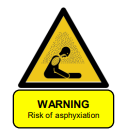Shipping Dry Ice with non Dangerous Goods
Carbon Dioxide, solid most commonly known as Dry Ice is not regulated when transporting non-dangerous goods by Road under the ADR Regulations. That is certainly not the case for other modes of transport it falls under Class 9 Miscellaneous Hazards,
Why is Dry Ice UN1845 considered Dangerous?

When your skin comes in contact with solid Carbon Dioxide (Dry Ice) it can cause cold burns. Prolonged exposure may lead to frostbite and hypothermia.
It is an asphyxiant even at low concentration levels so it may impair people’s balance, awareness, and judgement.
Carbon Dioxide Solid starts to sublimate (turn from a solid state to a gas) the gas is 1.5 times heavier than air, and the risk of asphyxiation increases in enclosed areas, small rooms, and vehicles.
It should never be stored in airtight vessels. Warm temperatures cause the formation of high amounts of gas and may lead to the bursting of the vessel.
Any spillage from an insecure load would lead to a higher rate of sublimation.
So what is Carbon Dioxide, solid or Dry Ice used for?
Dry Ice is typically used for cooling purposes and is used by multiple industries such as Pharmaceuticals, Food & Beverage. It is also used by farmers for branding of cattle and in the Entertainment industry for visual effect purposes in theatres and stage performances.
Transporting Carbon Dioxide, Solid UN1845 by Air Transport

When transporting Dry Ice by air cargo you must ensure that you follow the requirements specified under the IATA Dangerous Goods regulations.
The packages used for Dry Ice shipments must be designed in a way to permit the release of carbon dioxide gas, so the package does not rupture from a build-up of pressure during the flight. The release of the gas can be achieved by not taping the seams of the package. We would recommend using a packaging supplier that understands the requirements for shipping dry ice, they will provide you with a manufacturer summary card, which should be followed to ensure your package is compliant.
In addition to the packaging requirements, the dangerous goods regulations should be followed for the marking and labelling of the packages. This is to ensure that any party that comes into contact with the dry ice package is aware of the increased risk.
Although Carbon, Dioxide, solid or dry ice shipments are a Class 9 Hazard, when shipping items that are non-hazardous, there is no requirement to complete a Shipper’s Declaration. The airline will still conduct an acceptance checklist process to ensure all shippers are compliant with the Air Dangerous Goods regulations, They will, of course, reject your shipment if you are found to be non-compliant.
The airline need to understand how many kilos of dry ice are in the packages so they can ensure they comply with the aircraft ventilation guidelines for safety reasons.
How can I ship Dry Ice by Air?
If you need to transport Carbon Dioxide, solid as part of your responsibilities you need to hold a Civil Aviation Authority (CAA) certification in the transport of dangerous goods by Air. United Kingdom CAA certificates are recognised in many countries in the world as an excellent competent authority standard.
Our CAA-approved Carbon Dioxide, solid or Dry Ice course is available as e-learning (online course).
There are many benefits from choosing this type of training method, that our customers tell us about.
5 reasons to do an online training course with Logicom Hub:
- No need to sit through a 3-day dangerous goods by air certification course covering classes not relevant to you
- Focused learning means that you can concentrate on just the danger that you transport.
- Training can be completed at your own pace, allowing optimum flexibility in time, location and ability.
- It is interactive learning and user-friendly – not just screen reading.
- You get a qualification and certificate of training at the end.
Find out more about our Dry Ice course details and specifics HERE
Contact the team at Logicom Hub Ltd on 0330 912 5041 or email: [email protected] for any questions relating to the transport of dangerous goods.


